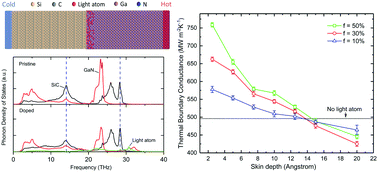Effect of light atoms on thermal transport across solid–solid interfaces
Abstract
Thermal transport across solid interfaces is of great importance for applications like power electronics. In this work, we perform non-equilibrium molecular dynamics simulations to study the effect of light atoms on the thermal transport across SiC/GaN interfaces, where light atoms refer to substitutional or interstitial defect atoms lighter than those in the pristine lattice. Various light atom doping features, such as the light atom concentration, mass of the light atom, and skin depth of the doped region, have been investigated. It is found that substituting Ga atoms in the GaN lattice with lighter atoms (e.g. boron atoms) with 50% concentration near the interface can increase the thermal boundary conductance (TBC) by up to 50%. If light atoms are introduced interstitially, a similar increase in TBC is observed. Spectral analysis of interfacial heat transfer reveals that the enhanced TBC can be attributed to the stronger coupling of mid- and high-frequency phonons after introducing light atoms. We have also further included quantum correction, which reduces the amount of enhancement, but it still exists. These results may provide a route to improve TBC across solid interfaces as light atoms can be introduced during material growth.

- This article is part of the themed collection: 2019 PCCP HOT Articles


 Please wait while we load your content...
Please wait while we load your content...